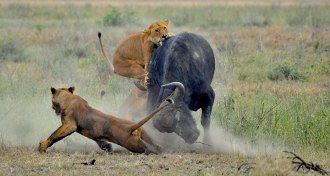News
-
 Planetary Science
Planetary ScienceAsteroid impacts may explain Venus’ missing oxygen
Asteroid impacts on Venus might have helped sequester oxygen left behind when Earth’s sister planet lost its water, new simulations show.
-
 Health & Medicine
Health & MedicineLess vitamin D and melatonin bad for multiple sclerosis
Vitamin D and melatonin play important roles in multiple sclerosis.
-
 Life
LifeHumans adjust walking style for energy efficiency
Humans can adjust their steps to walk in a way that uses the least amount of energy.
By Meghan Rosen -
 Anthropology
AnthropologyFossils suggest new species from human genus
Undated South African cave fossils may reveal a new species in the human genus.
By Bruce Bower -
 Neuroscience
NeuroscienceMisfolded proteins implicated in more brain diseases
Alzheimer’s, other disorders show similarity to Creutzfeldt-Jakob disease and other prion infections.
-
 Life
LifeSmall number of genes trigger embryo development
New views of early embryo development reveal differences between humans and mice.
-
 Oceans
OceansEarth got first whiff of oxygen 3.2 billion years ago
Photosynthesis by early cyanobacteria pumped oxygen into Earth’s oceans 200 million years earlier than once thought, new geochemical analyses show.
-
 Environment
EnvironmentMolting seals shed mercury along with fur
Seals spew amassed mercury when they shed, creating hotbeds of pollution in otherwise pristine coastal environments.
By Beth Mole -
 Materials Science
Materials ScienceGraphene shows signs of superconductivity
Ultrathin sheets of carbon can conduct electrical current with no resistance at low temperatures.
By Andrew Grant -
 Environment
EnvironmentLatest BPA replacement seeps into people’s blood and urine
Replacements for BPA called BPS and BPSIP may raise health risks for cashiers.
By Beth Mole -
 Astronomy
AstronomyFirst known exoplanets have few counterparts
The first known exoplanets were discovered around pulsars — probably one of the least likely places to have been found, astronomers now say.
-
 Animals
AnimalsSame math describes relationship between diverse predators and prey
From lions to plankton, predators have about the same relationship to the amount of prey, a big-scale ecology study predicts.
By Susan Milius